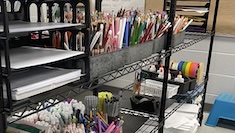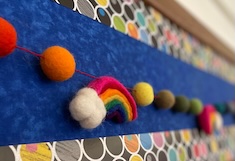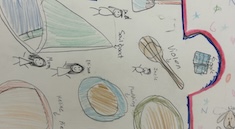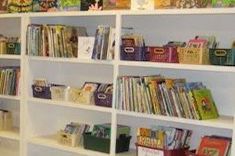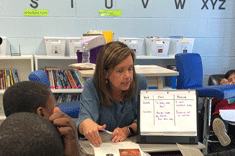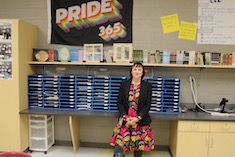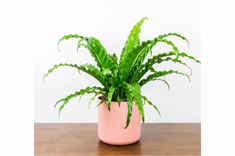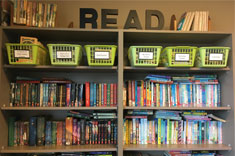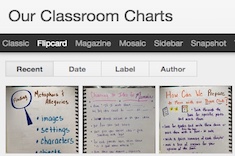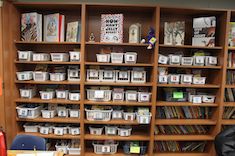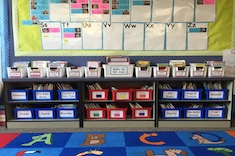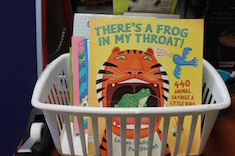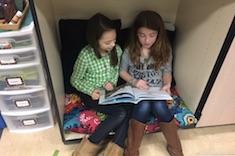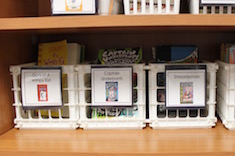Classroom Design
There's been a remarkable amount of brain research demonstrating how crucial environments are for learning. Cozy, well-lit and well-organized spaces are essential for literacy learners of any age. The constraints teachers face in designing and organizing their classrooms are enormous -- from irritated fire marshals to fear of lice infestations, with limited budgets always at the forefront. You'll be inspired by these beautiful classrooms, created by teachers who manage to design spaces any reader or writer would love.
Latest Content
Classroom Tour: Portable Tools for Regulating Emotions
In a classroom tour, Mandy Robek shares a collection of portable and personalized tools to help students regulate their emotions.
Classroom Tour: Whole-Class Meeting Space
In a classroom tour, Mandy Robek shares the purpose and design of her whole-class meeting space.
Classroom Tour: Creating and Living a Classroom Charter
In a classroom tour, Mandy Robek offers a wise approach to developing a classroom vision with her students. They begin by discussing the way they would like to feel in the classroom. Then they determine the actions that will help them feel those ways. Finally, they make a plan for what to do when they don’t feel supported in the classroom.
Classroom Tour: Classroom Supplies
In a classroom tour, Mandy Robek offers a unique and powerful approach to community supplies in her classroom.
Classroom Tour: Flexible Seating
Mandy Robek shares a variety of seating choices students have in her classroom. She explains the reason for her choices and how she manages a classroom where no one has an assigned seat.
I Am a Listener Who…
Melissa Quimby challenged herself to unpack her identity as a teacher who listens. She discovered clear and repeatable actions that all educators can use to be intentional listeners. Schools become safer spaces when students feel heard. What new things might you try to create a safer space for children?
Building Trust in Our Classrooms
Tara Barnett and Kate Mills remind us that more important than the physical layout of the classroom or the assessments we’ll give is the type of community we’ll become. Building a brave and enthusiastic community of learners is the foundation that everything else stands on. They share a community-building experience that can be adapted for any age.
Classroom Tour: Manipulatives and Books
In a classroom tour, Mandy Robek shares the thoughtful ways she pairs math manipulatives and books while providing easy access to the tools for students. She also promotes engineering and design with access to building blocks and parts.
Classroom Tour: Kinds of Spaces to Help Learning Blossom
Mandy Robek takes time to consider different places students will use in the classroom. She considers books, portable learning spaces, and the way learning will blossom over time in her third-grade classroom.
Creating a Space
Gwen Blumberg clearly outlines different kinds of spaces for our classrooms and libraries. She was inspired by David Thornburg’s Learning Space model where he suggests creating campfires, watering holes, and caves to support different kinds of learning.
Reclaiming Space: Weeding to Grow a Healthy Library
Books, like gardens, need to be tended to regularly for the whole library to thrive. Gigi McAllister gives tips for anyone in the weeding process for their school or classroom library.
Morning Hike
Gwen Blumberg helps us consider and create space for a variety of personalities and learning needs. Inspired by a morning hike, she takes her observations and applies them to give space for all students to learn.
Putting Together the Pieces of a Classroom (Classroom Organization)
When Julie Cox moves into a smaller classroom, she realizes that to make it a room where students learn and thrive, she needs to shift her mindset. Rather than simply putting things where they fit, she asks three questions to make intentional decisions that will support learning.
From a Blank Canvas to a Community Space
Jodie Bailey approaches setting up her math classroom as a blank space with an invitation for students to engage in establishing identity, creativity, and collaboration.
Building a Classroom Library with Students (and Navigating the Tricky Parts)
Tammy Mulligan leads us through the process of giving primary students the reins for building and organizing the classroom library . . . and offers tips for navigating the tricky parts.
QuickTake: Leave Space for Personalization
Melissa Quimby advises leaving space for students to personalize the classroom when they arrive to start the new school year.
Setting Up the Intervention Room
Dana Murphy guides reading specialists in setting up intervention rooms to welcome readers.
Quick Take: Using Mailboxes for Private Feedback
Christy Rush-Levine shares her system for streamlining passing papers and offering a place for private feedback.
Quick Take: Simple Classroom Library Organization
Christy Rush-Levine shares her simple system for organizing her massive classroom library.
A Minimalist Classroom
Mandy Robek adjusts her mindset of preparing her classroom according to COVID guidelines and discovers an open heart and mind as she prepares a “minimalist classroom.”
When a Library Whispers
Leigh Anne Eck personifies her classroom library by sharing the lessons it whispers when we take the time to listen. This is a practical guide to keeping your classroom library timely and relevant.
Rotation of the Classroom Library
Inspired by a closet clean-out, Leigh Anne Eck considers the way a seasonal rotation is also good for classroom libraries.
A New System for Anchor Charts
Dana Murphy develops a love-hate relationship with the faded anchor charts peeling away from her classroom walls. She finds a move to anchor charts in a sketchbook and a website for chart images improves the quality of her charts and their usefulness.
Managing Take-Home Books
Sending books home with young readers is essential. Cathy Mere gives lots of practical tips for designing a take-home books program and communicating with families about what young readers need.
Spring Cleaning
Jennifer Schwanke shares some quick tips for spring cleaning of classrooms and literacy supplies.
Keeping the Classroom Library Current
Franki Sibberson explains how she watches students closely and adjusts her library based on what she sees all year long.
Weeding a First-Grade Library
Bitsy Parks has a simple seven-step process for a hard day’s work of weeding out her first-grade classroom library.
Bin of the Week
Shari Frost and a teacher she is assisting notice some bins collecting dust in the classroom library. When the teacher resists removing the books, they work together to find creative ways to help students develop enthusiasm for neglected series and authors.
Flexible Seating: Mid-Year Tweaks with Book Nooks
Have you revisited your classroom design since September? Andrea Smith and her fourth graders get over the midwinter blahs by refreshing classroom seating together.
Reaction and Intention: Rethinking the Library in Early Winter
Mary Lee Hahn finds some of her fifth-grade readers are stuck in ruts by early winter. Her solution involves some radical changes to her classroom library over winter break.
Browse Content By
Type
Category
- Assessment Tools
- Big Fresh Archives
- Booklists
- Choice Numeracy
- Classroom Design
- Common Core
- Community Building
- Conferring
- Content Literacy
- Digital Literacy
- English Language Learners
- Equity
- Family Relations
- Free Samples
- Guiding Groups
- Leadership
- Literacy Coaches
- Mentor Texts
- Minilessons
- New Teacher Mentors
- Podcasts
- Poetry
- Quote Collections
- Reading Strategies
- Self Care
- Struggling and Striving Learners
- Talking and Listening
- Teacher Study Groups
- Teaching Reading
- Teaching Writing
- Word Study and Vocabulary
Author
- Melissa Quimby
- Nawal Qarooni
- Gwen Blumberg
- Julie Cox
- The Lead Learners
- Hannah Tills
- Josie Stewart
- Ruth Metcalfe
- Mallory Messenger
- Becca Burk
- Jodie Bailey
- Vivian Chen
- Mary Brower
- Tiffany Abbott Fuller
- Stephanie Affinito
- Ruth Ayres
- Leigh Anne Eck
- Heather Fisher
- Shari Frost
- Julie Johnson
- Suzy Kaback
- Gigi McAllister
- Shirl McPhillips
- Melanie Meehan
- Cathy Mere
- Debbie Miller
- Tara Barnett and Kate Mills
- Tammy Mulligan
- Dana Murphy
- Bitsy Parks
- David Pittman
- Brenda Power
- Heather Rader
- Matt Renwick
- Mandy Robek
- Christy Rush-Levine
- Gretchen Schroeder
- Jen Schwanke
- Brian Sepe
- Katherine Sokolowski
- Stella Villalba
- Jennifer Vincent
Grade Level
Choice Literacy Membership
Articles
Get full access to all Choice Literacy article content
Videos
Get full access to all Choice Literacy video content
Courses
Access Choice Literacy course curriculum and training

